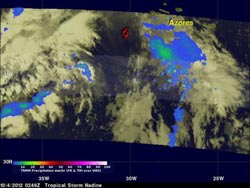NASA notes Nadine now no more

TRMM data on Oct. 3 at 10:49 p.m. EDT showed that Nadine was producing light to moderate rainfall (blue/green) in an area well east of the center of circulation, while the center (red symbol) was rain-free. The approaching cold front that would help bring about Nadine's demise was generating rainfall west of Nadine's center.<br><br>Credit: SSAI/NASA, Hal Pierce<br>
NASA's Tropical Rainfall Measuring Mission (TRMM) satellite passed above long-lasting Nadine for the last time before the tropical storm's dissipation on October 4, 2012 at 0249 UTC (10:49 p.m. EDT October 3, 2012).
TRMM measures rainfall from space and there was very little remaining in Nadine when it passed overhead. Rainfall data from TRMM's Microwave Imager (TMI) and Precipitation Radar (PR) showed that Nadine was producing light to moderate rainfall in an area well east of the center of circulation, while the center was rain-free.
TRMM data showed that the approaching cold front that would help bring about Nadine's demise was generating rainfall west of Nadine's center.
According to NOAA Hurricane Ginger lasted 28 days in the Atlantic Ocean in 1971. In the Pacific Ocean Hurricane John, renamed Typhoon John when it crossed the International Dateline holds the record with a 31 day lifetime during August and September 1994.
Although not the longest-lived tropical cyclone, Nadine is in the top 50 longest-lasting tropical cyclones in either ocean basin.
Media Contact
More Information:
http://www.nasa.govAll latest news from the category: Earth Sciences
Earth Sciences (also referred to as Geosciences), which deals with basic issues surrounding our planet, plays a vital role in the area of energy and raw materials supply.
Earth Sciences comprises subjects such as geology, geography, geological informatics, paleontology, mineralogy, petrography, crystallography, geophysics, geodesy, glaciology, cartography, photogrammetry, meteorology and seismology, early-warning systems, earthquake research and polar research.
Newest articles

Sea slugs inspire highly stretchable biomedical sensor
USC Viterbi School of Engineering researcher Hangbo Zhao presents findings on highly stretchable and customizable microneedles for application in fields including neuroscience, tissue engineering, and wearable bioelectronics. The revolution in…

Twisting and binding matter waves with photons in a cavity
Precisely measuring the energy states of individual atoms has been a historical challenge for physicists due to atomic recoil. When an atom interacts with a photon, the atom “recoils” in…

Nanotubes, nanoparticles, and antibodies detect tiny amounts of fentanyl
New sensor is six orders of magnitude more sensitive than the next best thing. A research team at Pitt led by Alexander Star, a chemistry professor in the Kenneth P. Dietrich…





















